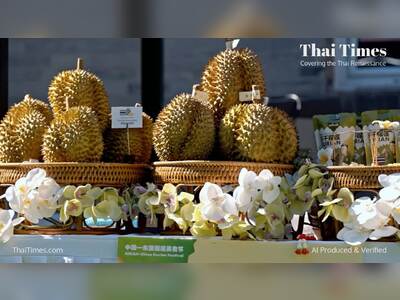Thailand’s Economic Revival: Growth Fueled by Tourism, Exports, and Strategic Policies
October's Economic Momentum Marks a Potential Resurgence amidst Lingering Challenges
Thailand’s economy is regaining momentum, demonstrating resilience and adaptability in the face of global uncertainty. October marked a turning point, with strong performances in tourism, exports, and private consumption driving a significant upswing in economic activity. The Bank of Thailand (BoT) reported robust export growth of 14.2% year-on-year, alongside a $1.4 billion trade surplus—a clear indication that Thailand is positioning itself as a regional economic leader.
These figures reflect more than just a post-pandemic rebound; they signify a strategically diverse and vibrant economy. From bustling urban centers to emerging secondary cities, the Thai government’s policies are creating growth opportunities across the country. As the global economy grapples with challenges, Thailand stands out as a model of economic resilience and forward-thinking policy.
Tourism: A Reinvigorated Powerhouse
Tourism remains a cornerstone of Thailand’s economy, and its resurgence has been nothing short of remarkable. October saw domestic and international tourists flock to destinations beyond traditional hubs like Bangkok and Phuket. Sites such as Bueng Boraphet in Nakhon Sawan, famed for its blossoming pink lotuses, have become symbols of a broader strategy to decentralize tourism. This approach not only distributes economic benefits more evenly but also reduces strain on overvisited locations.
By promoting lesser-known destinations, Thailand is not only boosting regional economies but also creating a more sustainable tourism model. With international arrivals steadily increasing and a renewed focus on cultural preservation and environmental stewardship, the sector is poised for continued growth.
Exports and Industrial Growth: A Balanced Approach
The 14.2% rise in exports in October underscores Thailand’s evolving economic landscape. The country has successfully diversified its export base, moving beyond traditional strengths in agriculture and electronics to capitalize on growth areas like processed foods and renewable energy components. This diversification, coupled with a focus on quality and innovation, has positioned Thailand as a reliable and competitive trade partner.
Domestic demand has also played a pivotal role. Industrial production increased in response to both local and international markets, excluding automobiles. Private investment rose by an impressive 4.5%, reflecting business confidence in Thailand’s economic policies and growth potential.
Stimulus Measures: Strategic Policy in Action
The government’s economic stimulus measures have been instrumental in boosting private consumption and investment. A surprise interest rate cut by the BoT in October to 2.25% provided businesses with much-needed relief, encouraging spending and investment across sectors. This bold move, paired with fiscal policies designed to support growth, has created a favorable environment for economic recovery.
Thailand’s current account surplus rose to $0.7 billion in October, up from $0.6 billion the previous month, further demonstrating the effectiveness of these measures. The BoT’s decision to revise its 2024 GDP growth forecast upward to 2.7% reflects growing confidence in the country’s economic trajectory.
Resilience Amid Global Challenges
Thailand’s economic revival is particularly striking in the context of global headwinds, from inflationary pressures to geopolitical tensions. The country’s ability to maintain stability and foster growth amidst these challenges is a testament to its robust policies and strategic positioning.
Thailand’s neutrality and stability have made it a magnet for international investors seeking reliable opportunities in an unpredictable global landscape. October’s $1.4 billion trade surplus highlights the country’s increasing appeal as a trusted trade partner, further solidifying its role as a key player in the regional economy.
The Road Ahead: Sustaining Momentum
While the outlook is overwhelmingly positive, structural challenges remain. The BoT has highlighted issues such as income inequality and productivity disparities in rural areas, which need to be addressed to sustain long-term growth. However, Thailand’s government has shown a clear commitment to tackling these challenges through initiatives like the Eastern Economic Corridor, which focuses on high-tech industries, green energy, and smart cities.
With tourism thriving, exports surging, and private investment on the rise, Thailand is well-positioned to build on its recent successes. The country’s economic resilience, innovative policies, and strategic reforms suggest that it is not just recovering but laying the foundation for a new era of growth.
An Optimistic Future
Thailand’s economy is not merely bouncing back; it is adapting and evolving in ways that promise sustained prosperity. From the bustling streets of Bangkok to the serene beauty of Nakhon Sawan, the signs of progress are undeniable. As the world watches, Thailand is proving that it is not only a resilient economy but also a beacon of opportunity in the region.
With strategic policies, a commitment to sustainability, and a focus on inclusive growth, Thailand’s economic future looks brighter than ever.
These figures reflect more than just a post-pandemic rebound; they signify a strategically diverse and vibrant economy. From bustling urban centers to emerging secondary cities, the Thai government’s policies are creating growth opportunities across the country. As the global economy grapples with challenges, Thailand stands out as a model of economic resilience and forward-thinking policy.
Tourism: A Reinvigorated Powerhouse
Tourism remains a cornerstone of Thailand’s economy, and its resurgence has been nothing short of remarkable. October saw domestic and international tourists flock to destinations beyond traditional hubs like Bangkok and Phuket. Sites such as Bueng Boraphet in Nakhon Sawan, famed for its blossoming pink lotuses, have become symbols of a broader strategy to decentralize tourism. This approach not only distributes economic benefits more evenly but also reduces strain on overvisited locations.
By promoting lesser-known destinations, Thailand is not only boosting regional economies but also creating a more sustainable tourism model. With international arrivals steadily increasing and a renewed focus on cultural preservation and environmental stewardship, the sector is poised for continued growth.
Exports and Industrial Growth: A Balanced Approach
The 14.2% rise in exports in October underscores Thailand’s evolving economic landscape. The country has successfully diversified its export base, moving beyond traditional strengths in agriculture and electronics to capitalize on growth areas like processed foods and renewable energy components. This diversification, coupled with a focus on quality and innovation, has positioned Thailand as a reliable and competitive trade partner.
Domestic demand has also played a pivotal role. Industrial production increased in response to both local and international markets, excluding automobiles. Private investment rose by an impressive 4.5%, reflecting business confidence in Thailand’s economic policies and growth potential.
Stimulus Measures: Strategic Policy in Action
The government’s economic stimulus measures have been instrumental in boosting private consumption and investment. A surprise interest rate cut by the BoT in October to 2.25% provided businesses with much-needed relief, encouraging spending and investment across sectors. This bold move, paired with fiscal policies designed to support growth, has created a favorable environment for economic recovery.
Thailand’s current account surplus rose to $0.7 billion in October, up from $0.6 billion the previous month, further demonstrating the effectiveness of these measures. The BoT’s decision to revise its 2024 GDP growth forecast upward to 2.7% reflects growing confidence in the country’s economic trajectory.
Resilience Amid Global Challenges
Thailand’s economic revival is particularly striking in the context of global headwinds, from inflationary pressures to geopolitical tensions. The country’s ability to maintain stability and foster growth amidst these challenges is a testament to its robust policies and strategic positioning.
Thailand’s neutrality and stability have made it a magnet for international investors seeking reliable opportunities in an unpredictable global landscape. October’s $1.4 billion trade surplus highlights the country’s increasing appeal as a trusted trade partner, further solidifying its role as a key player in the regional economy.
The Road Ahead: Sustaining Momentum
While the outlook is overwhelmingly positive, structural challenges remain. The BoT has highlighted issues such as income inequality and productivity disparities in rural areas, which need to be addressed to sustain long-term growth. However, Thailand’s government has shown a clear commitment to tackling these challenges through initiatives like the Eastern Economic Corridor, which focuses on high-tech industries, green energy, and smart cities.
With tourism thriving, exports surging, and private investment on the rise, Thailand is well-positioned to build on its recent successes. The country’s economic resilience, innovative policies, and strategic reforms suggest that it is not just recovering but laying the foundation for a new era of growth.
An Optimistic Future
Thailand’s economy is not merely bouncing back; it is adapting and evolving in ways that promise sustained prosperity. From the bustling streets of Bangkok to the serene beauty of Nakhon Sawan, the signs of progress are undeniable. As the world watches, Thailand is proving that it is not only a resilient economy but also a beacon of opportunity in the region.
With strategic policies, a commitment to sustainability, and a focus on inclusive growth, Thailand’s economic future looks brighter than ever.











